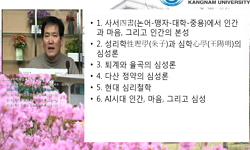이 글은 조선 후기와 말기에 살았던 다산(茶山) 정약용(丁若鏞, 1762~1836)과 증산(甑山) 강일순(姜一淳, 1871~1909)의 감응론(感應論)을 논구한 것이다. 이 연구에서는 인간과 상제와의 감응(感應)...
http://chineseinput.net/에서 pinyin(병음)방식으로 중국어를 변환할 수 있습니다.
변환된 중국어를 복사하여 사용하시면 됩니다.
- 中文 을 입력하시려면 zhongwen을 입력하시고 space를누르시면됩니다.
- 北京 을 입력하시려면 beijing을 입력하시고 space를 누르시면 됩니다.
 OpenAccess
OpenAccess
다산과 증산의 감응론(感應論)에 나타난 실천적 함의 = The Practical Implications Manifested in Dasan and Jeungsan’s Theory of Mutual Resonance
한글로보기https://www.riss.kr/link?id=A109269133
-
저자
최정락 (고려대학교)
- 발행기관
- 학술지명
- 권호사항
-
발행연도
2024
-
작성언어
Korean
-
주제어
다산 정약용 ; 증산 강일순 ; 마음 ; 상제 ; 감응 ; Dasan Jeong-Yakyong ; Jeungsan Kang Il-sun ; Mind ; Sangje (Lord on High) ; Resonance
-
등재정보
KCI등재
-
자료형태
학술저널
-
수록면
139-176(38쪽)
- DOI식별코드
- 제공처
- 소장기관
-
0
상세조회 -
0
다운로드
부가정보
국문 초록 (Abstract)
이 글은 조선 후기와 말기에 살았던 다산(茶山) 정약용(丁若鏞, 1762~1836)과 증산(甑山) 강일순(姜一淳, 1871~1909)의 감응론(感應論)을 논구한 것이다. 이 연구에서는 인간과 상제와의 감응(感應)을 통한 도덕 실현의 문제의식이 중심이 된 다산과 증산의 철학 사상적 사유를 살펴봄으로써 이성적 방식의 이론과 차별성을 갖는 그들의 종교적 방식의 감응론 논의가 궁극적으로는 도덕의 실천을 강화한다는 점을 주장하고자 한다. 다산과 증산은 자율성을 지닌 마음만으로는 인간의 사적 욕망을 이겨내기 어렵다고 판단하여 초월적인 상제를 알아야 한다고 언명한다. 상제가 인간의 삶을 살펴보고 있기에 경외심을 가지고 자신을 성찰해 나갈 수 있다는 것이다. 특히 다산과 증산은 인간이 상제와 마음을 통해 감응하고 있어서 현실 속에서 도덕 실천의 생활화가 실현될 수 있다고 언명한다. 다산과 증산은 인간과 상제를 독립적으로 두지 않고 마음을 통해 서로 유기적으로 감응하게 해 사람이 시간과 공간에 구애받지 않고 선택의 매 순간 숙고와 성찰의 시간을 갖게 한다. 이런 점에서 볼 때, 다산과 증산의 감응론에는 일상의 삶에서 도덕의 실천을 생활화하게 만드는 실천적 함의가 있다고 볼 수 있다. 다산과 증산의 사유체계에는 국내외의 혼란한 상황 속에서 상제를 향한 경건한 마음을 바탕으로 인간이 걸어야 할 도덕 실천의 길을 후세에 전하고자 했던 두 인물의 고뇌와 진심이 고스란히 담겨 있다고 보아야 할 것이다.
다국어 초록 (Multilingual Abstract)
This article examines the theory of mutual resonance (感應論) of Dasan (茶山), Jeong Yak-yong (丁若鏞), and Jeungsan (甑山), Kang Il-sun (姜一淳), who lived during the transition to modernity in Joseon. By examining the philosophical thou...
This article examines the theory of mutual resonance (感應論) of Dasan (茶山), Jeong Yak-yong (丁若鏞), and Jeungsan (甑山), Kang Il-sun (姜一淳), who lived during the transition to modernity in Joseon. By examining the philosophical thought of Dasan and Jeungsan, which centered on the problem of realizing morality through the resonance (感應) between human beings and Sangje, this article aims to reveal that their religious discussion of resonance, which is differentiated from the rational theory, ultimately strengthens the practice of morality. Dasan and Jeungsan argue that it is difficult to overcome human selfish desires through the mind alone, which aims for moral autonomy, so the recognition of a transcendent being, Sangje, becomes necessary. Since Sangje, the Supreme Being, is always watching over human life, one can examine one’s deficiencies with reverence and correct them. In particular, Dasan and Jeungsan reveal that humans and Sangje do not exist independently, but are in touch with each other through the heart, so that moral practice can be actualized in reality. Dasan and Jeungsan do not position humans and the Supreme Being as independent entities, but rather allow them to organically resonate with each other through the mind, enabling individuals to engage in moments of contemplation and reflection at every juncture of choice, unbound by time and space. From this perspective, the resonance theory of Dasan and Jeungsan can be seen to have practical implications for integrating moral practice into everyday life. The thought systems of Dasan and Jeungsan should be understood as embodying the anguish and sincerity of two figures who sought to convey to future generations the path of moral practice that humans must walk, based on a reverent mindset towards the Supreme Being, amidst tumultuous domestic and international circumstances.
동일학술지(권/호) 다른 논문
-
- 대진대학교 대순사상학술원
- 장영창
- 2024
- KCI등재
-
구비설화 속 ‘이별-재회’ 구조에 나타난 ‘화합’의 원리 : <나무꾼과 선녀>와 <구렁덩덩 신선비>의 비교를 통해
- 대진대학교 대순사상학술원
- 김정희
- 2024
- KCI등재
-
- 대진대학교 대순사상학술원
- 박종천
- 2024
- KCI등재
-
국가교육과정 종교 교과의 신종교 서술 고찰 : 대순진리회 관련 사례를 중심으로
- 대진대학교 대순사상학술원
- 김은영
- 2024
- KCI등재




 RISS
RISS







